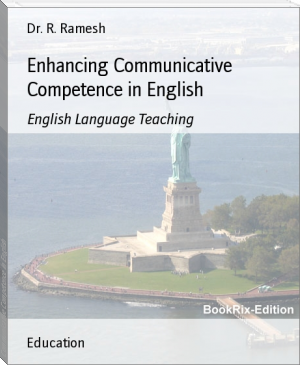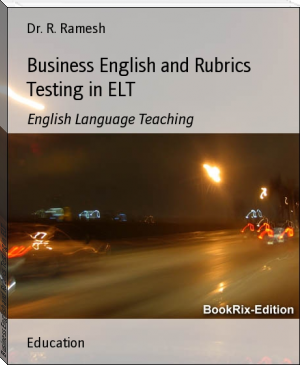Cognitive Development in English Language Teaching, Rajesh Lane [best motivational books for students txt] 📗

- Author: Rajesh Lane
Book online «Cognitive Development in English Language Teaching, Rajesh Lane [best motivational books for students txt] 📗». Author Rajesh Lane
( b ) Opinion gap activities:
The students are asked to think about their lives and the people they know or have known. They had to find out at least two people each, who have influenced their lives. They may be their parents, relatives, friends or personalities from history or literature. They had to note down some points in order to be able to tell the rest of the class briefly how these people have influenced them.
( c ) Role Play:
Role play is a way of bringing situations from real life into the classroom in a dialogue form.
The students are asked to use their imagination. Learners have to do many roles, or they pretend to be a different person. (e.g, a businessman).
( i ) One student imagines he is a businessman, other students ask him questions about his daily work.
( ii ) A group of students imagine they are friends, planning a holyday together. They try to decide where to go and what to do.
( iii ) One student has lost her bag. She is at police station reporting it to the police. The other student is the police officer and asks for more details.
For Roleplay the suitable situations are selected from every day life; ( e.g, shopping, holidays, using local transport , etc… )
( d ) Simulation:
Learners of the class are divided into an Alpha group and Beta group. Teacher facilitates the learners to speak by arranging the group, by arranging the chairs in circle, by circulating different contextual topics. Here teacher acts as a chair person or referee.
In another way the learners are divided as main speakers, minor speakers, reporters and audience. Speakers who have a special interest in the matter are main speakers. The minor speakers are those who have lot of ideas but will join in from time to time by asking questions or by interrupting the main speakers.
( e ) Creative Speaking:
Among the peer groups they create the context and speak. For example, ‘Moon people‘, ‘ If I am the President ‘, etc……. Learners create new ideas and speaks on them to the class. Every learner gives different expressions with their expectations. Here different contexts are circulated to speak creatively.
( f ) Free Speaking:
Learners individually create context and speak freely. Some of their contexts are ‘against fixed notations’, ‘equilibrium’, ‘against infanticides’, ‘supporting against budget’, etc. Free speaking depends on learner’s mind what s / he intends to speak.
( g ) Reporting real events:
The learner presents the real events, the knowledge of which s/he has acquired from news papers, Television and from other mass medias. The events may be; ‘Cassini space craft’s recent discovery’, ‘recent invention of bio- polymer substituting for polythene products’, ‘accidents’, ‘international events’, etc.
( h ) Interviewing people:
Here learner comes to know the ideas of others through interviewing other students. For example the learner may ask the questions on topics like their ideas about future career, interesting field, a holiday they have experienced, favourable sports, etc.
( i ) Conducting a survey:
The students formulate a questionnaire, conduct a survey and present a report based on the results. The questionnaire may be to identify the likes and dislikes of learners. Some of the topics may be ‘smoking in public places’, ‘which party will win the election’ ?, ‘rights of politicians’, ‘the best eating places in town’ etc. Eventually the student presents the report to the class.
( j ) Observing and expressing:
Teacher brings to the classroom a picture of a tree, human skeleton, an engine etc. Teacher gives it to the learners to see and observe what is in the picture. Then learners are asked to describe the parts.
( k ) Carrying out mini-projects:
Here the peer group of learners work with their group. They analyse the problem and the solution. The study may be on water pollution which changes the river water as drainage water, traffic control etc. Each group member gathers information and the leader presents the same in classroom with their solution for the problem.
( l ) Giving directions:
A fairly large scale, clear and readable street map of the local area is displayed on the wall, or if there are sufficient copies, the students can use them in pairs. Each student is asked to locate a place on the street map which is his/her real or imagined home. The most important thing is that the student’s partner should not have the information.
The teacher asks one partner in each pair to invite the other, for a supper or a party, which includes explaining the directions to his/her home. The address and phone number s/he gives to the partner and with reference to a landmark which is clearly marked on the map the direction to the house has to be explained. For example, “ Get off the bus at the new bus stand….”, “ When you come out the bus stand…… “. His / her partner then asks the time of coming, the colour of house etc…
( m ) Jigsaw story telling:
In this tasks the use of picture stories to stimulate narrative speaking is established. Several picture sequences are prepared and the same would be cut up into single pictures for distribution to individual students. The students are arranged in groups. Each group or individual in a group has the same picture which was cut.
Each group is asked to assemble the parts into a narrative, and make necessary modifications to produce a logical story. Each individual tells different stories and it ends with teacher discursion.
( n ) Asking and giving advice:
In this tasks the learner asks the teacher to get the solution to a problem or advice on a matter. Peer group may give advice to the individual. The learner may ask for instance about effective speaking, water pollution, mental-torture, etc. Each learner asks and clarifies with both the teacher





Comments (0)